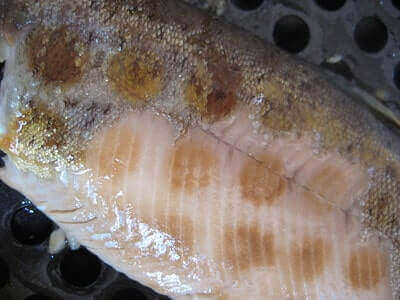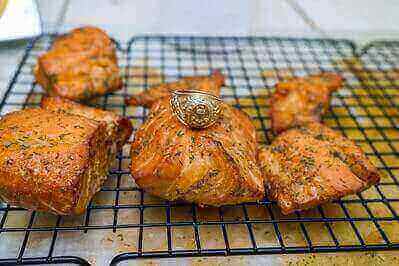Disclosure: We may earn commissions if you purchase products after clicking on a link from our site.
If you have a smoker or charcoal grill, you can quickly learn how to smoke fish at home. Learn how to do it and which fish are best for smoking.

Trout, swordfish, tuna; there are so many choices for smoking fish!
Smoking fish is an easy and delicious way to enjoy seafood at home. It’s also a great way to add flavor and texture to any meal. You can create simple dishes like smoked salmon on toast or in sandwiches or more complex recipes such as smoked trout with lemon-dill sauce.
Whether you have a smoker or charcoal grill, it’s easy to learn how to smoke fish at home. But there are a few safety tips and flavoring know-how you’ll want to know before you begin. That way, you can guarantee that your smoked fish is safe and unforgettable.
What’s the right way to smoke fish? Read on for the best steps and tips to cook fish in a smoker.
Table of Contents
How to Smoke Fish Safely
Learning how to smoke fish can be a great way to make dinnertime more fun, but it can also be dangerous if not done properly. Here are some potential consequences of not properly preparing and storing smoked fish:
Food Poisoning – Eating improperly smoked fish can lead to food poisoning, which can even be lethal in severe cases.
Bacteria Growth – Most bacteria that cause food poisoning can thrive under the conditions normally found in the preparation and storage of smoked fish. Botulism is one of the most harmful bacteria linked to contaminated food, and eating improperly smoked fish increases the risk.
Put Safety First
Safety first! Two requirements must be met to ensure that smoked fish is safe to eat.
First, heat the fish to 160°F internal temperature and maintain that temperature for at least 30 minutes. Second, brine or salt the fish properly.
With the right preparation, salting, and smoking techniques, you can enjoy any fish with the assurance that it’s safe to eat.

How to Prepare the Fish
Preparing fish for smoking is an art that varies depending on the species. Salmon need to be split, bottom fish should be filleted, and small fish such as herring and smelt require heading and gutting. West Coast species like shad, sturgeon, smelt, herring, steelhead, salmon, mackerel, and sablefish are especially good candidates for smoking. These fish have a high oil content which makes them absorb smoke faster and have better texture.
Regardless of which type you’ve chosen, make sure it’s of high quality. Smoking won’t help if there are issues with the fish that could affect food safety.
When thawing frozen fish, do it in a cool place or water and clean it thoroughly to remove all traces of blood, slime, and bacteria. Cut the pieces into equal sizes to ensure uniform salt absorption, and don’t let them sit for more than 2 hours before smoking.
Salt is what preserves smoked fish so make sure enough has been absorbed. It may be difficult to determine this without chemical analysis, but observing some basic principles will help!
Ingredients for Smoked Fish
What do you need other than the fish and salt? Here are the 5 main ingredients you will need to cook fish in a smoker:
- 6 pounds of fillets with skin on
- 1/3 cup light brown sugar
- 1-quart water
- 1/2 cup kosher salt
- Seasoning
Once you have these all gathered, check to ensure you are using the right wood chips for smoking. Woods like maple and pecan are good for bringing out the flavor of the fish without overpowering it.
Best Smoked Fish Seasoning Choices
Get creative with what seasonings or dry rubs you use to bring out flavors unique to yourself and your tastes! You can try experimenting with some popular seasonings to give your smoked fish a unique and flavorful twist.
Tarragon: There are 3 main types of tarragon: French, Russian, and Mexican. The first two are more widely used. Tarragon adds a unique anise flavor to dishes.
Parsley: Parsley adds an herbaceous flavor to seafood dishes and can be paired well with other seasonings.
Chives: Chives lend a subtle onion and garlic note to food, creating a robust flavor that complements smoked fish perfectly.
Dill: Dill is strongly flavored and has green undertones that can add a fresh element to your smoked fish dish.
Smoked Paprika: Rich in flavor, smoky paprika adds a sharp kick that pairs wonderfully with most smoked fish recipes.
Ginger: Ginger brings out the smokiness of the food while adding a spicy-sweet taste.
Turmeric: Turmeric has anti-inflammatory properties and adds a vibrant yellow color as well as earthy, peppery flavors to your dish.
Cumin: Cumin lends an earthy aroma and partially sweet taste that complements smoky dishes nicely. As a bonus, this spice also has health benefits!
You should also try adding a pinch of cinnamon to your smoked fish. This will provide a sweet, spicy flavor that works perfectly with most smoked dishes.
Customize Smoked Fish Spice Blends
Trying individual spices is great. But you can also make a master blend that perfectly seasons your fish. Here are a few of our favorites.
Herby and Peppery: A tantalizing combination of herbs and spices, Herby & Peppery is the perfect flavor boost for your delicate seafood dishes. A mixture of 2.5 tablespoons dried dill, 1 tablespoon paprika, and 1 teaspoon lemon pepper will give you a unique taste that’ll keep your palate guessing. With these exciting combinations ready to go, your fish dish will surely be a success.
Savoury and Spicy: For an explosion of flavor, try 2 tablespoons ground caraway, 2 tablespoons of ground cumin, 1 teaspoon chili flakes, 1 teaspoon dried parsley, and a final dash of dried tarragon.
Earthy and Savory: Hearty and warming, this blend goes great with all kinds of smoked fish. To make it, mix 2 tablespoons ground of ground cumin, 1 tablespoon of ground coriander, 1 teaspoon of ground cardamom, and 1 teaspoon of ground turmeric.

What About Cajun Blackening?
Cajun blackening is an exciting and flavourful way to cook fish. To make your own Cajun blackening seasoning, combine 2 tablespoons of paprika, 2 teaspoons of garlic powder, and 1 teaspoon of white pepper. Next, add 1 teaspoon of cayenne pepper and 1 teaspoon of dried oregano. Finish the blend with a single teaspoon of dried thyme and a half teaspoon of ground black pepper.
Mix the ingredients in a bowl and store them in an airtight container for future use. When ready to blacken your fish, sprinkle it over both sides or dip the fillets into the mixture before smoking. Combining these three things gives the meat a dark crust and deep flavor.
Smoking Fish Instructions
Now that you have ready all the ingredients and special seasonings, it’s time to get smoking! Here are the steps for smoking fish:
- Soak the wood chips in water for at least an hour before smoking
- Combine the sugar and salt in a shallow bowl and season each fillet with this mixture
- Place the fillets on a preheated smoker or charcoal grill set up for indirect heat
- Add soaked wood chips to the fire every 30 minutes during cooking time
- Cook until internal temperature reaches 145°F
First, decide which type of fish you’d like to smoke. Generally speaking, smaller fish like work best for smoking, like whitefish and trout. You can also try larger fish like salmon or mackerel if you prefer.
Next, prepare your smoker or charcoal grill. Make sure that the grate is clean before you begin. If you’re using a charcoal grill, light it and wait for the coals to become gray-white before continuing.
Now it’s time to add the wood chips! Soak them in water for 15 minutes before adding them directly to the coals on your grill or into the smoker box attached to your smoker. Different types of wood impart different flavors, so do some research to figure out which type is best for the fish you’re smoking.
When the wood chips are ready, place your fish on the grate and close the lid or cover of your smoker or grill. Smoke the fish for 30 minutes to an hour, depending on its size and thickness.
You want it to be cooked through but not dry and overcooked. Once finished, take your smoked fish off the heat and let it rest for a few minutes before serving.

Storing Smoked Fish
Proper storage is essential to ensure your smoked fish is safe and delicious for days to come. You can refrigerate or freeze the fish (at temperatures below 38°F) if you don’t plan to eat it immediately.
Wrapping the fish in porous materials like cloth or paper toweling prevents “sweating” and mold growth. For even longer storage periods, tightly wrap and freeze the smoked fish as its low moisture content maintains its quality well.
Enjoy Your Delicious Smoked Fish Meal
Now you know how to smoke fish like a pro. Experiment by adding different spices to your smoked fish dishes for a unique flavor experience.
Variations such as tarragon, parsley, chives, dill, smoked paprika, ginger, turmeric, and cumin are popular choices that can take your dish to the next level. For even more depth of flavor, try adding a pinch of cinnamon too.
Seasoned Pioneers has all the best-selling spices you need to make the perfect meal. We also have seasoned salts, gourmet cooking sauces, and more. Check out our collection today!
The Bottom Line
How to smoke fish is not as difficult as it may seem. There are a few steps to take to safely smoke fish. In this article, we share information not only on how to smoke fish but also recipes to prepare fish.
If you fish for salmon, halibut, mackerel, and croaker, you can read how to catch salmon, how to catch halibut, how to catch mackerel, and how to catch croaker, to help you catch more of these fish.